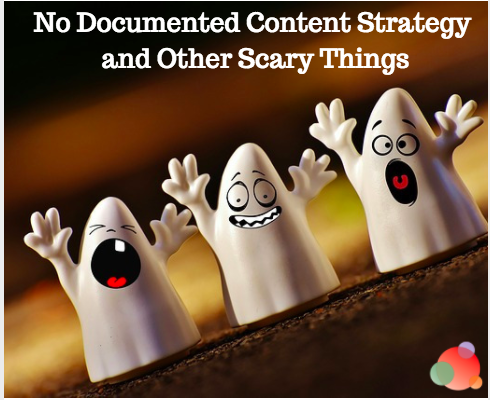While it is the third day of the last quarter of the year, it also is the month of Halloween.
So, we thought, let’s have a little fun with the holiday for ghosts and ghouls and goblins!
While some may equate Halloween to scary things (clowns, for instance, or It, which I still have not seen because my friends and family are sissies), there is much to do without being scared.
Especially in the communications business.
Sure, our profession can be stressful and scary.
I mean, CareerCast did list “PR executive” as one of the most stressful jobs on the planet.
As well, some of the statistics around the work we do aren’t glorious:
- Sixty-eight percent of B2B organizations don’t have a documented content strategy.
- Fifty-nine percent of marketers say they either don’t have the technology or the bandwidth/resources to personalize their content. Meanwhile, 53 percent say they lack the data to do so.
- Eighty-seven percent of B2B marketers say they struggle to develop compelling content.
But it doesn’t have to be so.
Just like I told Corina Manea as she was doing her last-minute freakout about going on vacation:
In our business, if it turns out you forgot something, no one will die.
We’re not doing brain surgery. Truly, no one will die.
Let’s put things in perspective and not let the stress overwhelm and scare us.
We are in control!
No Documented Content Strategy?
As it turns out, if you only engage in random acts of content—publishing content on whatever topic strikes a chord on any given day—you won’t reap all the benefits you could.
(This is a lesson I’ve personally had to learn because I love to write on whatever topic is top-of-mind at the time.)
If you take an integrated approach to your content marketing and bring together the PESO model, you’ll see vastly improved results.
You might even avoid some common pitfalls that impede many content marketing programs.
It all starts with a documented content strategy.
Not convinced?
There four all-too-common pitfalls.
- Not enough time to create content
- Not enough budget to create content
- Our industry is boring, and so is our content
- We’re targeting too many people with our content
To get past this and be among the 32 percent who do have a documented content strategy, read The Four Pitfalls (and Fixes) of Your PR Content Strategy.
It will help.
Can’t Personalize Your Content?
This one isn’t as difficult as we tend to make it—therefore, it should be lots less scary.
A few years ago, I wrote about my Starbucks experience.
It was so popular, it gained the attention of Howard Schultz.
Dan, the barista, and I were interviewed for Howard’s book, Pour Your Heart Into It.
Just a week ago, we were laughing at the internet fame we had during that time.
It was INSANE.
And it was all because we wrote notes to one another on Starbucks cups—for a full two years before we met in person.
(If you’ve not heard the story, it’s linked above. It’s worth checking out.)
This was a completely personalized content experience between me and a barista.
And it’s still one of my favorite stories to tell.
In fact, when he got married last month, we personalized cups as part of his wedding gift.
I love this story when people talk about how they can’t personalize content.
If a barista can do this for his customers, surely you can figure out how to do the same.
This is How to Personalize Your Content
Sure, you’re not going to send messages back and forth on cups, but there are some things you can do:
- Go through your sent mail to see what questions your clients, prospects, and peers ask you. This will create personalized content.
- Write down every question you people ask you in new business meetings. If you have sales and customer service teams, ask them to give you a list of questions they answer a lot. This is more personalized content.
- Check out your frequently asked questions page on your website. Perhaps it’s old and needs to be updated. Perhaps it doesn’t exist, but you have a draft of something sitting in a folder in Dropbox. Wherever you have them, check them out. They will provide ideas for even more personalized content.
If you need to make the personalized content experience less scary, read The Personalized Experience is a Marketing Trend for 2017.
It will help.
Not Developing Compelling Content?
There is a five-step process to creating compelling content…and it includes your customers and employees.
- Your customers and your employees tell your best stories.
- Stories humanize the company.
- Humanization creates kinship.
- Kinship drives purchase.
- Purchase creates more customer and employees.
Don’t ignore the stories you can tell by having your customers and employees talk about the product, the service, or the organization.
That’s when you’ll hit pay dirt because you won’t sound like all of your competitors.
No one has the same stories you have.
If you want to learn more about each of the five steps, read Five Steps to Create Compelling Content.
It will help.
The Month’s Scary Themes
We are going to spend the next four weeks making communications less stressful and scary.
Our upcoming themes are SCARY:
- Keyword research
- PR/marketing/content challenges
- Online learning
- Slack productivity hacks
There is plenty of content on this very blog to help you get past your fears, and learn new skills.
If, however, you want to shortcut your learning and have access to exclusive content (plus the Spin Sucks team), the PR Dream Team is to your rescue.
It is there to support, train, and help you overcome these fears…and more.
